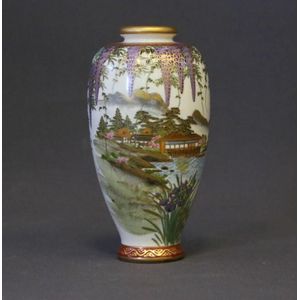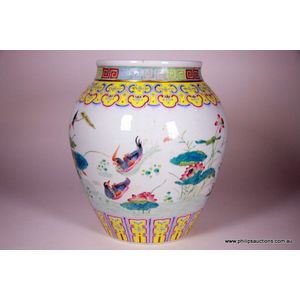Qing Dynasty Polychrome Vase with Wucai Palette
You must be a subscriber, and be logged in to view price and dealer details.
Subscribe Now to view actual auction price for this item
When you subscribe, you have the option of setting the currency in which to display prices to $Au, $US, $NZ or Stg.
- Ming Dynasty - The Ming Dynasty was a ruling dynasty of China from 1368 to 1644. It succeeded the Yuan Dynasty and preceded the Qing Dynasty. The Ming Dynasty was established by Zhu Yuanzhang, a former Buddhist monk who became a rebel leader and eventually overthrew the Mongol Yuan Dynasty. During the Ming Dynasty, China experienced a period of relative stability and prosperity. The government was centralized and bureaucratic, with the emperor at the top of the hierarchy. The Ming Dynasty is known for its cultural achievements, including the development of porcelain, the invention of movable type printing, and the construction of the Great Wall of China.
- Polychrome - Made or finished in many colours. For furniture, it is used to indicated a painted finish.
- Qing Dynasty - The Qing Dynasty was the last imperial dynasty of China, ruling from 1644 to 1912. It was established by the Manchu people, who originated from the northeastern region of China. The Qing Dynasty was preceded by the Ming Dynasty and followed by the Republic of China.
- Oviform /ovoid - The outline loosely resembling the shape of an egg.
- Lappet Decoration - In the context of furniture, ceramics, and oriental wares, the word "lappet" refers to a decorative motif that consists of a repeated pattern of stylized or abstracted "lappets."
A lappet in this context is a decorative element that resembles a small, hanging flap of cloth or fabric, but rather are stylized patterns that resemble the shapes and folds of lappets. They can be found on a wide range of objects, including furniture, vases, bowls, and plates.
Lappet decoration can take many different forms, but typically consists of a series of semi-circular or pointed shapes that are repeated in a continuous pattern. The shapes may be simple or highly ornate and may be arranged in a regular or irregular pattern. The design may also include other decorative elements, such as floral or foliate motifs.
Lappet decoration is often associated with Asian design traditions, and can be found on a wide range of objects from these regions, including Chinese porcelain, where lappet decoration is often used as a symbol of abundance and prosperity, and is believed to have protective and auspicious qualities.
This item has been included into following indexes:
- Chinese ceramics, dynasty mark or period - Hongxian mark 23
- Chinese ceramics, famille decoration - famille verte, Wucai, vases 148
-
Chinese ceramics, item type
- figurines 1,568
- vases, other 2,484
Visually similar items

A large Chinese polychrome vase, late Qing Dynasty (late 19th/early 20th century), of broad baluster form with a short neck and a waisted foot with a green ruyi lappet border to the collar enclosing pink and lemon blooms, the body with a continuous scene o

Satsuma vase. Pavillion & wisteria decoration. Red mark to base. Height 16 cm

A small signed Satsuma vase, Showa period, mid 20th century, mark probably for Koshida, the baluster vase with a waisted neck and a rolled rim, decorated with birds in an autumn toned maple tree above coloured flowers, with gilded highlights and between si

A Chinese famille rose pot, the tapering ovoid pot decorated to the body with a continuous lotus garden scene with auspicious cranes, ducks and other birds between lingxhi fungus, key fret and lappet borders on lemon and aqua grounds; bearing Qing Xuantong
